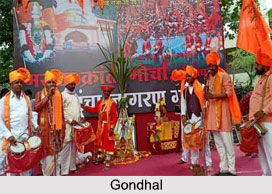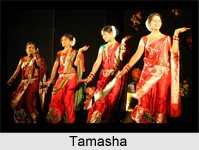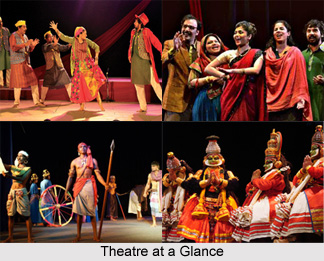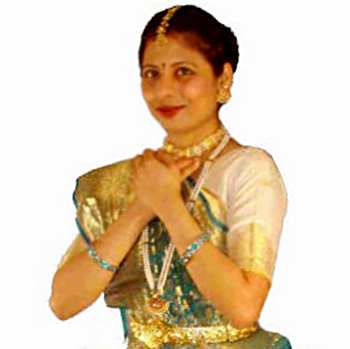Costumes of Karyala, incidentally, are indigenous and inexpensive. The white is that of rice or wheat flour, the black from the tava, or skillet (the chapatti cooking iron plate the griddle) the red from geroo (a kind of local red coloured earth). As for wigs and beards, these can be easily made from jute and other fibres available locally. Also the masks are prepared indigenously from tree barks and pulp as well as by carving wood.
The third item in the sequence is the famous Sahab Ka Swung. Here again the genius of the native Himachali is at its best. His drawing of the Sahab`s character as well as his household and attendants is so perfect and convincing that to repeat a cliche, it has to be seen to be believed. While the Sadhus in the first item had beards and tilaks and overalls, depicting different sects realistically and the devilish mischief-maker in the second swang Jhoolna, was made up grotesquely, the "Sahab" in this swang is given a mask. This again points to the innate discriminating sense of dramatic application of the unlettered Simla Karyalchi; Simla, because it was here that the Englishman with all his paraphernalia functioned, and it was here that the native Chaprasi, the bearer, the khansama, the ayah, the malan, the butler, had a close look at the "Sahab" and his motives and manner of living. As the scene opens, the audience is alluded to as a Mela, a Fair, by the Chaprasi who enters and cautions everybody, saying "Halla gulla band karo, Saab aa raha hai -"Hush, keep quiet, the Sahab is coming." And there the Sahab enters and asks the Chaprasi as to what is happening. He is told about the Mela, the Fair. Sahab says "All very good, please send for Mem Sahab and baba log as also the Khansama, the bearers etc." as he would like to camp there, while also doing some recruitment for the Army.
At this juncture a queer creature dressed up in multi-coloured rags and a conical cap, known as Sanyee, emerges representing the average reaction of the villagers, to the Sahab and his ensemble. Again there are in the Brechtian style, albeit intelligibly, duo dances of Sahab and Mem, songs by Malan and a chorus by the participants i.e. yellow Mem and red Sahab etc. A point that should be mentioned here is the stance that the village Karyalchies takes whenever some outsider comes to their village, which is to have the better of him in verbal repartee, thereby tickling and feeding the pride of the local inhabitants and scoring a plus point in communication. The funny man who encounters the Sahab and his household in this manner is known as Sanyee as mentioned before. This Sanyee is the prototype of other jesters, like Poorbia in Sadhu Ka Swung and the fire-eater of the second swang Jhoolna. That is to say every item has a main conductor, who has to introduce humour, although the overall composition of various characters in any of the skits resembles those of Shakespeare`s alone in "Mid-summer Nights Dream," like Bottom and company.
So in this Swang of Sahab, the village buffoon`s main thrust is to disarm the Sahab of his superiority, by firing at him shots of verbal nonsense and once this equation of equality with the Sahab is established, it provides an agreeable channel of communication, on equal level between the two, as well as the spectators. Sahab on his part also starts enjoying the lighter treatment of the whole thing and as such, does not mind a laugh at his expense and in the process develops a rapport with the village knave.
The sources of humour in all these cameos are by (a) punning on rhyming words, (b) oblique reference to the Institution of Father in various contexts and (c) by comment on distortion of speech and angularities in behaviour and other oddities. People will be surprised if I mention that there is no vulgar reference in any repartee although most recently the unfortunate trend has set in. Karyala is perhaps the only folk burlesque which is not obscene and is a conspicuous example of clean humour.
This Sahab Ka Swang is another item of considerable length and its duration, as that of any other item of Karyala presentation and performance, is flexible and adaptable. The presentation of the Karyala items is intimately connected with the immediate reactions of the audience and that is why this form of presentation is so very popular today in spite of film, radio and Television. And since there is no compulsion, of a script, of learnt up dialogues or the story telling from the Epics, the team of actors collectively is the freest creators, which in itself is a great challenge to their histrionic ability and quick wit and they meet it very admirably.




